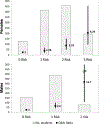Partner meeting place is significantly associated with gonorrhea and chlamydia in adolescents participating in a large high school sexually transmitted disease screening program
- PMID: 25211256
- PMCID: PMC6749175
- DOI: 10.1097/OLQ.0000000000000189
Partner meeting place is significantly associated with gonorrhea and chlamydia in adolescents participating in a large high school sexually transmitted disease screening program
Abstract
Background: From 2003 to 2012, the Philadelphia High School STD Screening Program screened 126,053 students, identifying 8089 Chlamydia trachomatis (CT)/Neisseria gonorrhoeae (GC) infections. We examined sociodemographic and behavioral factors associated with CT/GC diagnoses among a sample of this high-risk population.
Methods: Standardized interviews were given to infected students receiving in-school CT/GC treatment (2009-2012) and to uninfected students calling for results (2011-2012). Sex-stratified multivariable logistic models were created to examine factors independently associated with a CT/GC diagnosis. A simple risk index was developed using variables significant on multivariable analysis.
Results: A total of 1489 positive and 318 negative students were interviewed. Independent factors associated with a GC/CT diagnosis among females were black race (adjusted odds ratio [AOR], 2.27; confidence interval, 1.12-4.58), history of arrest (AOR, 2.26; 1.22-4.21), higher partner number (AOR, 1.75; 1.05-2.91), meeting partners in own neighborhood (AOR, 1.92; 1.29-2.86), and meeting partners in venues other than own school, neighborhood, or through friends ("all other"; AOR, 9.44; 3.70-24.09). For males, factors included early sexual debut (AOR, 1.99; 1.21-3.26) and meeting partners at "all other" venues (AOR, 2.76; 1.2-6.4); meeting through friends was protective (AOR, 0.63; 0.41-0.96). Meeting partners at own school was protective for both sexes (males: AOR, 0.33; 0.20-0.55; females: AOR, 0.65; 0.44-0.96).
Conclusions: Although factors associated with a GC/CT infection differed between males and females in our sample, partner meeting place was associated with infection for both sexes. School-based screening programs could use this information to target high-risk students for effective interventions.
Conflict of interest statement
No potential conflicts of interest identified for any of the authors.
Figures

Similar articles
-
School-Based Sexually Transmitted Disease Screening: Review and Programmatic Guidance.Sex Transm Dis. 2016 Feb;43(2 Suppl 1):S18-27. doi: 10.1097/OLQ.0000000000000283. Sex Transm Dis. 2016. PMID: 26779684 Free PMC article. Review.
-
School-based screening for Chlamydia trachomatis and Neisseria gonorrhoeae among Philadelphia public high school students.Sex Transm Dis. 2006 Oct;33(10):614-20. doi: 10.1097/01.olq.0000216010.43296.42. Sex Transm Dis. 2006. PMID: 16614587
-
Patterns of chlamydia/gonorrhea positivity among voluntarily screened New York City public high school students.J Adolesc Health. 2011 Sep;49(3):252-7. doi: 10.1016/j.jadohealth.2010.12.006. Epub 2011 Feb 17. J Adolesc Health. 2011. PMID: 21856516
-
Determining risk markers for gonorrhea and chlamydial infection and reinfection among adolescents in public high schools.Sex Transm Dis. 2009 Jan;36(1):4-8. doi: 10.1097/OLQ.0b013e3181860108. Sex Transm Dis. 2009. PMID: 18813031
-
Prevalence of Chlamydia trachomatis and Neisseria gonorrhoeae infection in adolescents in Northern Italy: an observational school-based study.BMC Public Health. 2016 Feb 29;16:200. doi: 10.1186/s12889-016-2839-x. BMC Public Health. 2016. PMID: 26927226 Free PMC article.
Cited by
-
School-Based Sexually Transmitted Disease Screening: Review and Programmatic Guidance.Sex Transm Dis. 2016 Feb;43(2 Suppl 1):S18-27. doi: 10.1097/OLQ.0000000000000283. Sex Transm Dis. 2016. PMID: 26779684 Free PMC article. Review.
-
Mathematical modeling study of school-based chlamydia screening: potential impact on chlamydia prevalence in intervention schools and surrounding communities.BMC Public Health. 2020 Sep 5;20(1):1363. doi: 10.1186/s12889-020-09466-y. BMC Public Health. 2020. PMID: 32891137 Free PMC article.
-
Potential for Point-of-Care Tests to Reduce Chlamydia-associated Burden in the United States: A Mathematical Modeling Analysis.Clin Infect Dis. 2020 Apr 15;70(9):1816-1823. doi: 10.1093/cid/ciz519. Clin Infect Dis. 2020. PMID: 31504314 Free PMC article.
References
-
- Sexually Transmitted Disease Surveillance, 2011. December 2012; Available at: http://www.cdc.gov/std/stats11/Surv2011.pdf.
-
- Asbel L, Newbern E, Salmon M, et al. School-based screening for Chlamydia trachomatis and Neisseria gonorrhoeae Among Philadelphia public high school students. Sex Transm Dis 2006; 33:614–620. - PubMed
-
- Cohen D, Nsuami M, Martin D, et al. Repeated school-based screening for sexually transmitted diseases: A feasible strategy for reaching adolescents. Pediatrics 1999; 104:1281–1285. - PubMed
-
- Nsuami M, Nsa M, Brennan C, et al. Chlamydia positivity in New Orleans public high schools, 1996–2005: Implications for clinical and public health practices. Acad Pediatr 2013; 13:308–315. - PubMed
-
- Mettey A, Anschuetz G, Lewis F, et al. Seven Years, 112,000 Tests Later: Trends From the Philadelphia High School STD Screening Program, in National STD Prevention Conference. Atlanta, GA: Centers for Disease Control and Prevention, 2010.
MeSH terms
Grants and funding
LinkOut - more resources
Full Text Sources
Other Literature Sources
Medical
Research Materials
Miscellaneous

